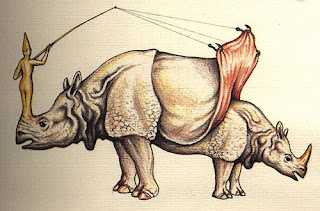
Shahzia Sikander, The Resurgence of Islam, 1999
From the book, Drawing Now, "...Sikander creates altogether contemporary work not by breaking conventions but by inverting them." Link
here for page that contains above image. Image also appears in book, Drawing Now, pp. 122-123.

Amy Cutler, Fermentation, gouache on paper, 2009.
From
Femme Art blog.
Amy Cutler is super cool: brooklyn artist, does very narrative / folktale and detailed paintings
"While I absorb references through the media there are always underlying personal meanings in my paintings. Often it will be a year or more before I feel like I fully understand why I selected certain images and painted them the way I did".
Link
here for the page that contains the above image.
 The Official Crumb Site
The Official Crumb Site

George Cruikshank, Massacre at St. Peter's, 1819. Link
here for more.


A Divine Comedy of Errors: Political Paintings by Saira Wasim
Paradoxes of Genre: the Epic Miniature
Teeming with figures captured in mid-action, paintings by Saira Wasim present grand narratives. If it weren’t for their petite size and two-dimensionality, they might be mistaken for Greek mythology, Baroque opera, epic film, or other monumental genres. Yet, these small paintings represent a singular creation, one that transcends any individual medium or genre. In Wasim’s hands, the centuries-old format of the miniature painting has been transformed into a stage for human drama, a jam-packed cinematic space that approaches the grandeur of Cecil B. DeMille and the glamour of Bollywood. Like the protagonists of such grand genres, Wasim’s characters gesticulate, prance, shoot, and fly in majestic style. They laugh and boast in hideous fashion, and morph into grotesque hybrid creatures that hint at transcendent themes of good and evil. Website
here.

Mid 19th Century Miniature Painting on Ivory of Princess Lamballe in a Sterling Blue Enamel Frame. Princess Lamballe was Marie Antoinette's best friend and was beheaded during the revolution for this reason. Link
here.

Xiaoqing Ding. From the Journal of Mythic Arts: News and Reviews. Link
here.
.jpg)
Moritz von Schwind, Ruebezahl, 1851. Image on page 105 in book, Drawing Now.

Moritz von Schwind, The Falkenstein Ride (1843-44).
The serious, devoutly religious mysticism of the early Romantic artists (such as Caspar David Friedrich in the north and the Nazarenes in the south) differed sharply from the fanciful imaginativeness of the later adherents of the movement, such as Moritz von Schwind. Like many other popular artists of the Biedermeier period, Schwind was more interested in the anecdotal than the purely symbolic or allegorical. The subject of the painting reproduced below is the legend of the knight Kuno von Sayn, who fell in love with the daughter of the castle lord von Falkenstein. The lord would only consent to the marriage if Kuno managed to create an accessible pathway through the impassable cliffs leading up to his castle – all in one night. In the end, Kuno achieved this monumental task with the help of underground elves, who offered their assistance in exchange for his promise to close down all of the silver mines in the mountain heights. This painting shows Kuno as he approaches the castle on horseback to claim his bride. Source is German History Documents. Link
here.

"Hansel and Gretel" and "Sleeping Beauty" (c. 1840)
First published in 1819, the Grimm brothers’ encyclopedic compendium of fairy and folk tales unites two seemingly contradictory cultural tendencies, each of which exerted an equally strong influence on all aspects of intellectual life in early nineteenth-century Germany. On the one hand, the collection reflects the Romantics’ obsession with all things mystical and supernatural, as well as their search for naïve and “organic” forms of expression unfettered by artificial social conventions. Within this cultural context, greater attention was paid to popular tales passed down through oral tradition. On the other hand, the Grimm brothers’ collection also reflects the neoclassical heritage of the Enlightenment, which encouraged rational progress and scientific study. It was in this spirit, too, that the Grimms sought to study and preserve the folk heritage of Europe. Although the folk tale was seen as an unmediated expression of the Germanic national spirit, its underlying themes and forms were also taken to be universal. Thus, old stories of German origin like “Hansel and Gretel,” were read alongside newer, more artful tales, such as “Sleeping Beauty,” composed by the seventeenth-century Frenchman Charles Perrault. Two lithographs (c. 1840) after drawings by Ludwig Emil Grimm. Source is German History Documents. Link
here.

San Francisco based artist,
Art Hazelwood.

Belgian artist, Oswald Cromheecke. Link
here for the flickr page.














.jpg)







































